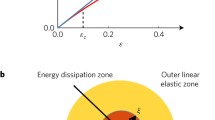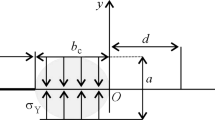Abstract
The Griffith energy balance fracture criterion, despite its central importance in the study of most fracture problems, has received very little experimental confirmation. One of the reasons for this is the inherent gross uncertainty in the value of the fracture surface energy γ in solids, This paper describes a simple experiment in which the rupture of a thin liquid film between two glass strips forced apart by a wedge is used to simulate the propagation of a crack. The resistance to rupture is provided by the surface tension of the liquid, which can be computed by observing the configuration of the bent glass arms and then compared with values measured by independent means. Such a comparison is made for a silicone oil, for which agreement in values of γ is obtained within the limits of experimental scatter, thereby permitting a direct confirmation of the energy balance equations.
Résumé
En dépit de son importance primordiale pour Pétude de la majorite des problièmes de rupture, le critère de rupture de Griffith basé sur un équilibre énergétique n'a été Fobjet que d'un nombre limité de confirmations experimentales.
Il faut en chercher Tune des raisons dans Pincertitude assez générale qui plane sur la valeur de l'énergie superficielle γ dans les solides. Le présent mémoire décrit un expérience simple, dans laquelle on fait usage d'un mince film liquide disposé entre deux plaques de verre que l'on sépare à Paide d'un coin, pour simuler la propagation d'une fissure.
La résistance à la rupture est matérialisée par la tension superficielle du liquide, laquelle peut être calculée en observant la configuration prise par des plaques de verre fléchies, et en procedant par voie comparative.
Une telle comparaison a été effectuée dans le cas d'une huile a base de silicone. Dans les limites de la dispersion experimentale, on a obtenu des valeurs de γ plausibles, ce qui a permis d'établir une confirmation directe des équations d'équilibre énergétique.
Zusammenfassung
Das Griffith -kriterium für das Energiegleichgewicht beim Bruch hat bisher trotz seiner Bedeutung für die meisten Probleme in Bruchuntersuchungen kaum experimentelle Bestätigung gefunden. Eine der Ursachen dafür ist die äusserst grosse Unsicherheit bei der Bestimmung der Bruchflächenenergieγ von Festkörpern. In vorliegender Arbeit wird eine einfache Versuchanördnung beschrieben, in der die Bruchfortpflanzung mit Hilfe eines zwischen zwei schmalen Glasplatten liegenden Flüssigkeitsfilmes nachgeahmt wird. Der Bruch wird ausgelöst indem die beiden Glasplättehen durch einen Kell auseinander getrieben werden. Der Bruchwiderstand wird von der Oberflächenspannung der Flüssigkeit bestimmt, welche aus der Durchbiegung der Glasplättchen berechnet werden kann. Für Silikonol stimmen die derart gefundenen Werte für γ innerhalb der experimentellen Fehlergrenzen mit unabhängig davon gemessenen Oberflächenspannungswerten überein. Damit werden die für das Energiekriterium abgeleiteten Gleichungen direkt bestätigt.
Similar content being viewed by others
References
A.A. GriffithPhil. Trans., A221, 163 (1920).
C.E. InglisTrans. Inst. Nav. Archit., 55, 219 (1913).
G.I. BarenblattAdv. Appl. Mech., 7, 55 (1962).
J.R. RiceSubmitted to J. Appl. Mech.
J.R. WillisJ. Mech. Phys. Solids, 15, 151 (1967).
J.W. ObreimoffProc. Roy. Soc., A127, 290 (1930).
J.J. Benbow and F.C. RoeslerProc. Phys. Soc., 70, 201 (1957).
J.J. GilmanJ. Appl. Phys., 31, 2208 (1960).
A.D. McEwan and G.I. TaylorJ. Fluid Mech., 26, 1 (1966).
W.L. Bragg and J.F. NyeProc. Roy. Soc. Lond., A190, 474 (1947).
Author information
Authors and Affiliations
Rights and permissions
About this article
Cite this article
Burns, S., Lawn, B. A simulated crack experiment illustrating the energy balance criterion. Int J Fract 4, 339–345 (1968). https://doi.org/10.1007/BF00185268
Received:
Issue Date:
DOI: https://doi.org/10.1007/BF00185268




